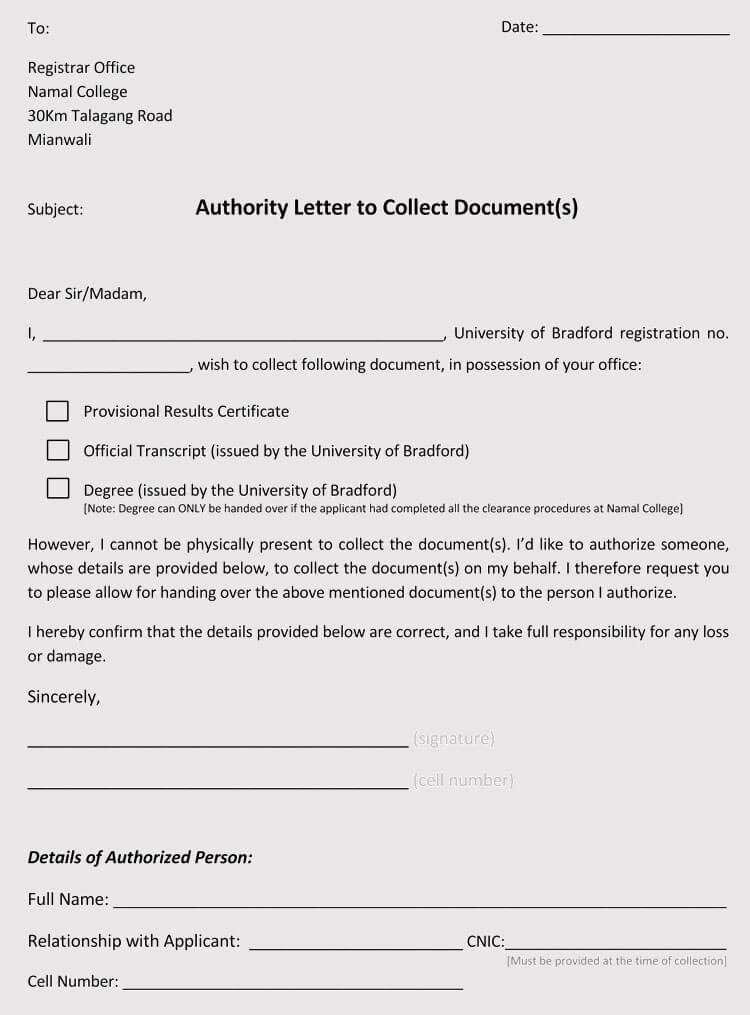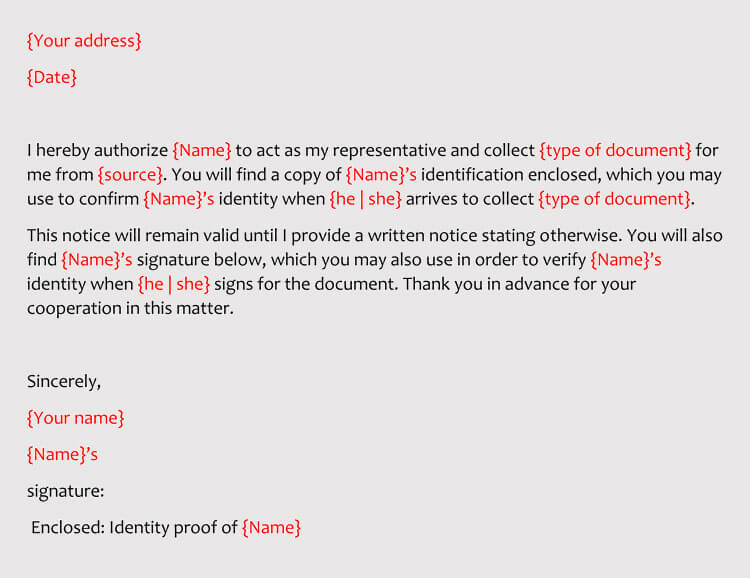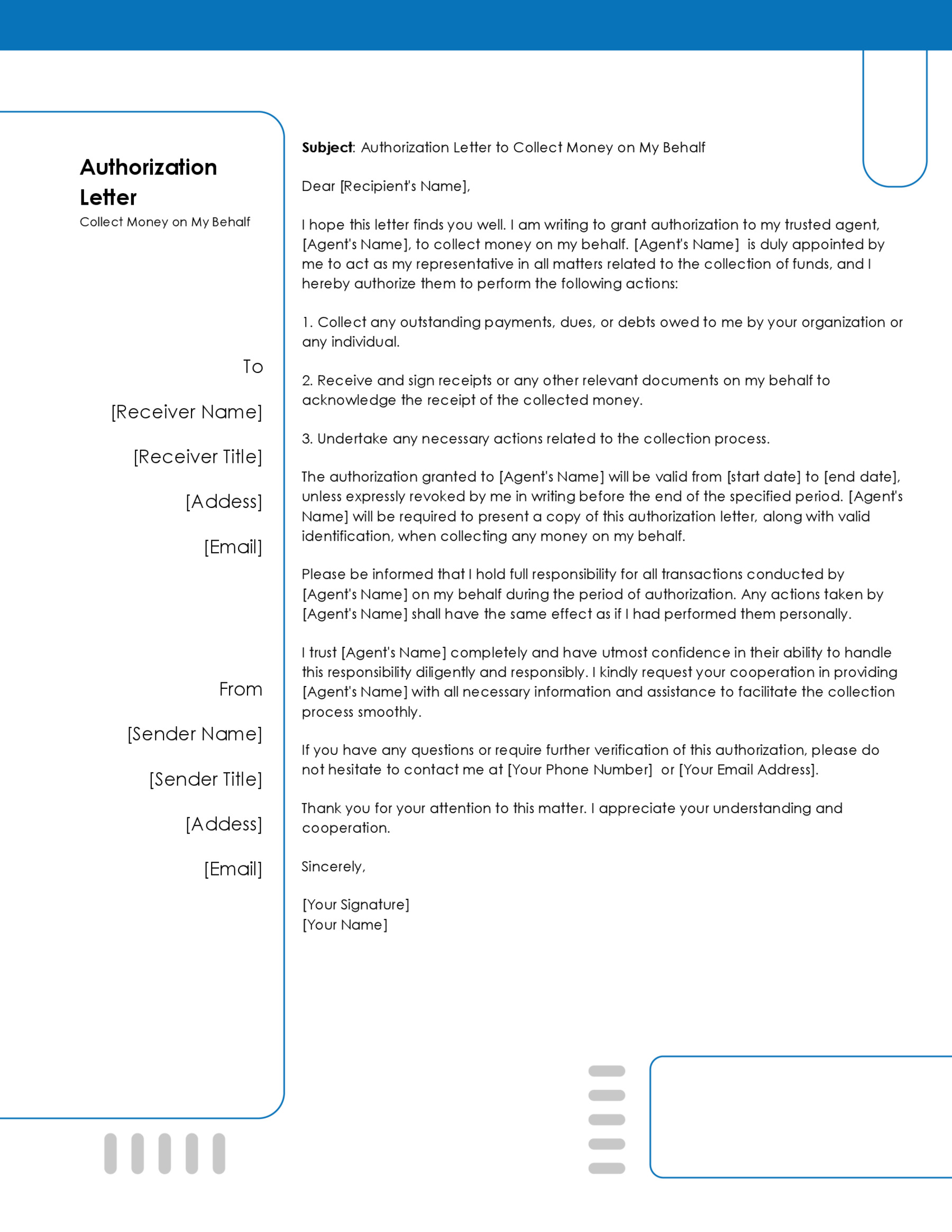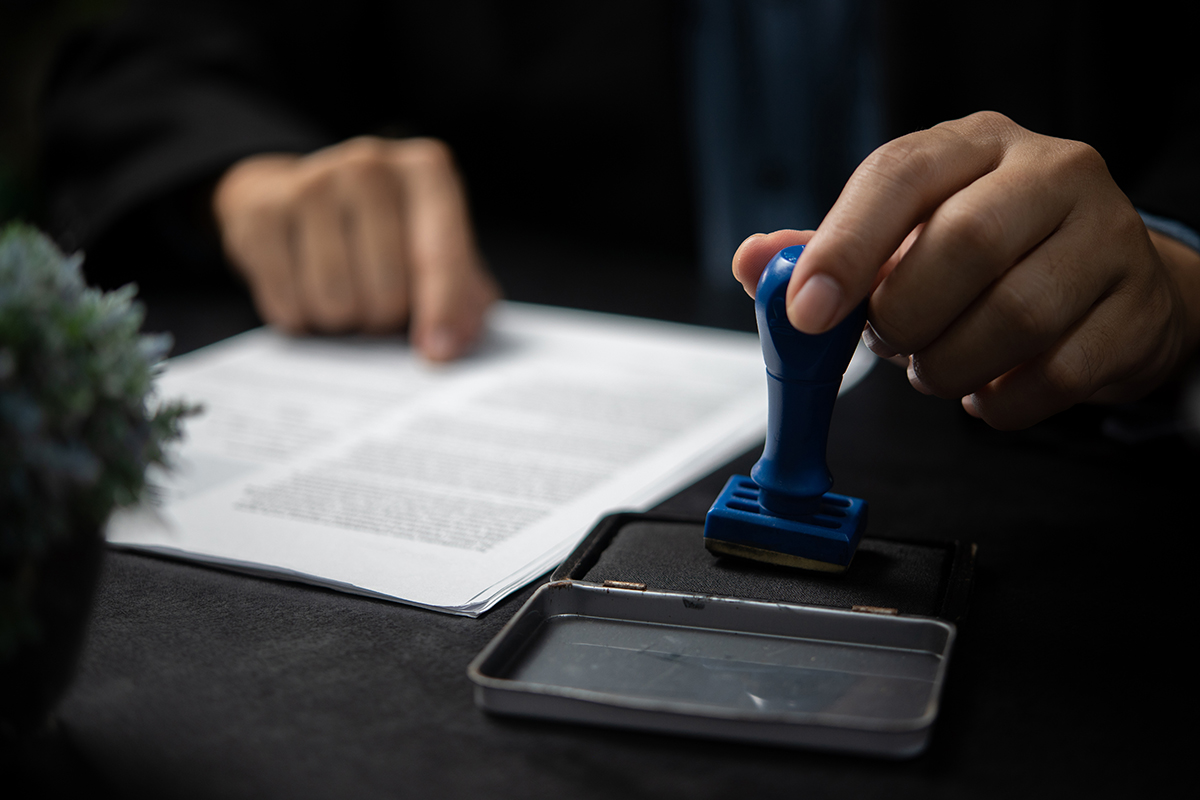An Authorization Letter to Collect Documents is a legal document that entrusts a person to collect essential documents on behalf of the person who wrote the letter. This letter can help to avoid any legal complications or misunderstandings. The letter will include the actions that the entrusted person can perform and the actions they are not permitted to do.
These are often used to avoid legal ramifications due to the improper handling of private information and legal papers. They have a wide range of applications, as they can be used to collect medical records, educational records, degrees, certificates, and other important private documents.
- With the help of a sample letter, an individual would get an idea about the formatting.
- A sample letter can guide an individual about the kind of content to include in the letter.
- It would also assist in including the relevant and required information, which is necessary for the collection of important documents.
- A sample makes it easier to write the complete letter within a short span of time.
Free Downloads
Here is a collection of pre-built downloadable templates in Word format for you to craft your letter quickly. Get your hands on these for free and save your time and effort.
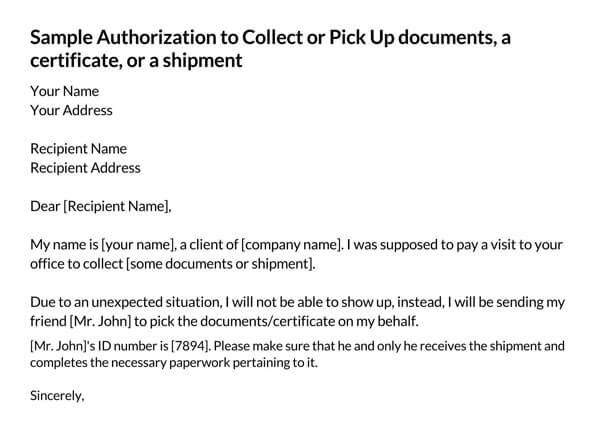
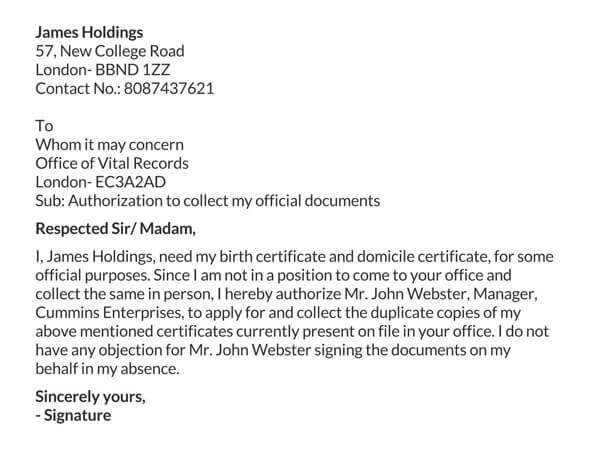
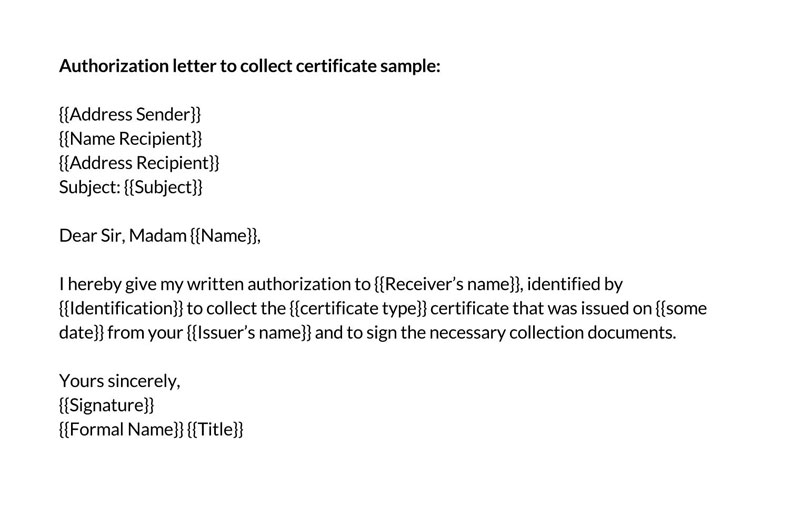
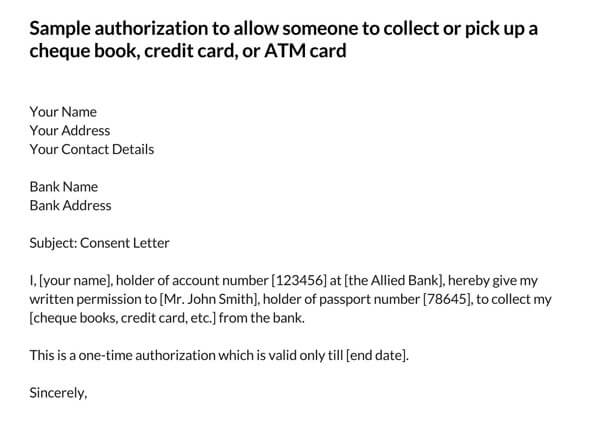
How to Write
Mentioned below are steps that an authorizer can use to write the letter:
Section 1: Introduction
This section introduces the parties involved in the authorization process:
Introduction of the authorizer
The Letter of Authorization starts by introducing the person permitting another person to collect documents on their behalf.
This includes:
- The full name of the authorizer, such as “Mrs. Lilah Patrick,”
- The full address of the authorizer. The address includes the country, state, city, name of the street, and house number. The zip code for the area can also be added.
EXAMPLE
“USA, MN, Columbus, Camp 3 Rd Ne”.
- The contact information of the authorizer, such as their phone number.
- The date of writing the document is also required, preferably in the format of DD/MM/YYYY
Provide the recipient’s information
The information of the recipient is required afterward. This information can either pertain to the person who will be inspecting the letter or the department doing so.
The information required includes:
- The full name of the recipient or the name of the entity receiving the letter
EXAMPLE
“Mrs. Jane Doe” or the hospital’s name.
- The full address of the recipient, whether they are a singular person or a department.
EXAMPLE
The address of the hospital.
- The recipient’s contact information is also needed, such as their phone number.
Authorized person’s details
Details of the person being given the authorization are required next. The details need to include:
- The full name of the person who is granted the authorization such as: “Mr. Albert Smith”.
- The full address of the person being granted the authorization.
- Information regarding the document that will confirm the identity of the person includes the type or name of the document and the ID number.
EXAMPLE
“Passport no. 6384762.”
Section 2: Body
The body of the letter will include information regarding the purpose of the letter, the authorized actions, and other details such as the university registration number. The documents that are provided with the letter are also included here.
The information that is required within this paragraph includes:
- The purpose of the letter– The purpose of the authorization and the person’s name who is being given this authorization.
EXAMPLE
“I am writing this letter to grant permission to Mr. Smith to collect my official transcript from the University of London”.
- A list of all the authorized actions and the unauthorized actions.
EXAMPLE
“Mr. Smith is permitted to collect my medical records from the hospital. However, he is not permitted to make any decisions regarding my medical condition or medications.”
- A suggestion of an appropriate course of action.
EXAMPLE
“Kindly provide the required documents.”
- The timeframe for this authorization is also provided. After the timeframe ends, the letter will be nullified.
EXAMPLE
“I grant this authorization from the 1st of July to the 25th of August of the year 20XX”.
Section 3: Conclusion
The end of the letter is where the signature of the authorizer will be. Additional information regarding any terms that this letter is subject to can also be found here.
- The letter ends with “Sincerely” or “Best regards”, followed by the name and title of the authorizer.
- There will be space at the end to provide the signature of the authorizer.
Tips for Authorization Letter to Collect Documents
The following tips may be followed for writing an effective letter:
- Formal intonation: The letter is written in a strictly formal language. There should not be any informal language or slang, as this letter is used for business purposes. Thus, talking in a formal language can open new avenues in business.
- Purpose: The purpose of the letter needs to be stated as clearly as possible to avoid any vagueness and misunderstandings.
- Clarity: Clear, concise, and accurate language should be used. If confusion occurs, it will be quite problematic and time-consuming to correct the confusion.
- Valid period of authorization: The authorization period must be valid for the letter to be accepted; otherwise, it will be rejected. An authorization period cannot occur in the past.
- Specify the assigned task: The assigned task should be as clear as possible to avoid any mix-up. Vague tasks can grant unwanted access or the opposite, i.e., fewer permissions than what is wanted.
- No indentation at the end of the letter: A space of multiple lines (three or four) is better to be left at the end of the letter to give space for the signature above the name and title of the authorizer.
Authorization Letter Format To Collect Documents on Your Behalf
Given below is a format that can assist a person in writing the letter:
sample
Name
Address
Location
Contact No.
To,
Whom it may concern
Address
Location
Subject: _________
Dear Sir/Madam,
I, (Name) need my (mention any important document, for example, a birth certificate) for official purposes. I authorize Mr/Ms. (Name) to collect this document on my behalf as I am unable to attend your office due to (XYZ) reasons. I have no objection to Mr/Ms. (Name) signing the required documents in my absence.
Yours Sincerely,
Name
Related: Sample Authorization Letters to Receive Documents
Sample Authority Letter for the Collection of Documents
In this section, a free sample authorization letter has been curated, specifically designed for those in need of a clear and formal means to grant permission to someone for the collection of essential documents.
sample
Date: November 30, 20XX
To Whom It May Concern,
I, Jane Doe, residing at 123 Maple Street, Springfield, hereby authorize Mr. John Smith, of 456 Oak Avenue, Brookside, to collect the Property Lease Agreement on my behalf. Due to my ongoing business travels abroad, I am unable to personally collect the document.
Mr. Smith will provide his driver’s license (ID No. AB1234567) as identification. This letter serves as my full consent for him to receive the Property Lease Agreement and perform any necessary actions related to its collection from today, November 30, 20XX, until December 31, 20XX.
Please ensure that no additional documents are handed over apart from the specified Property Lease Agreement. For any queries or to verify this authorization, please contact me at my email: janedoe@email.com or phone: +1234567890.
Thank you for your cooperation and understanding in this matter.
Sincerely,
Jane Doe
123 Maple Street
Springfield
Contact: +1234567890
Email: janedoe@email.com
Analysis
The analyzed letter serves as a useful guide for someone looking to write a similar authorization letter due to its clear structure, professional tone, and inclusion of all necessary details.
Here’s a breakdown of its key components and how they contribute to its effectiveness:
- Date: The writer has placed the date at the top of the letter, which provides a timestamp for when the authorization is given, which is crucial for record-keeping and relevance.
- Clear Purpose Statement: The opening sentence clearly states the letter’s purpose—authorizing a named individual to collect a specific document on the writer’s behalf. This direct approach ensures no ambiguity about the letter’s intent.
- Identification of Authorized Person: The writer has included the full name and a form of identification for the authorized person (e.g., a driver’s license with an ID number), which adds a layer of security and verification. This ensures that the document is released to the correct individual.
- Reason for Authorization: The writer explains why the authorizer cannot collect the document personally (e.g., travel obligations), provides context, and justifies the need for authorization. This isn’t always necessary, but it can add clarity.
- Duration of Authorization: The inclusion of the authorization’s time frame is a critical element. It sets clear boundaries on how long the authorization is valid, which is essential for legal and record-keeping purposes.
- Limitations of Authorization: The writer explains that no other documents should be released, ensuring that the authorization is specific and limited to the intended purpose, preventing any misuse.
- Contact Information: Providing contact details like a phone number and email address offers a way for the recipient to verify the authorization or clarify any doubts, adding an extra layer of security.
- Signature and Sender’s Details: The author’s name, address, and contact information at the end are essential for verification and correspondence purposes.
Each element is crafted to contribute to the letter’s clarity, specificity, and formality, making it a reliable template for creating a professional and effective authorization letter. This structure ensures that all necessary information is conveyed clearly and concisely, minimizing the risk of misunderstandings or errors in the document collection process.
Related: Sample Authorization Letters of Collection
Final Thoughts
The Authorization Letter to Collect Documents is a document that grants permission to other individuals to collect documents that are otherwise not allowed access to by anyone other than the first party that the document pertains to. The letter will include information regarding the authorizer, the recipient of the paper, the person who is granted the authorization, and the authorization itself. The letter is written in a formal language that is accurate, clear, and brief. The signature of the authorizer will be at the bottom of the letter.
